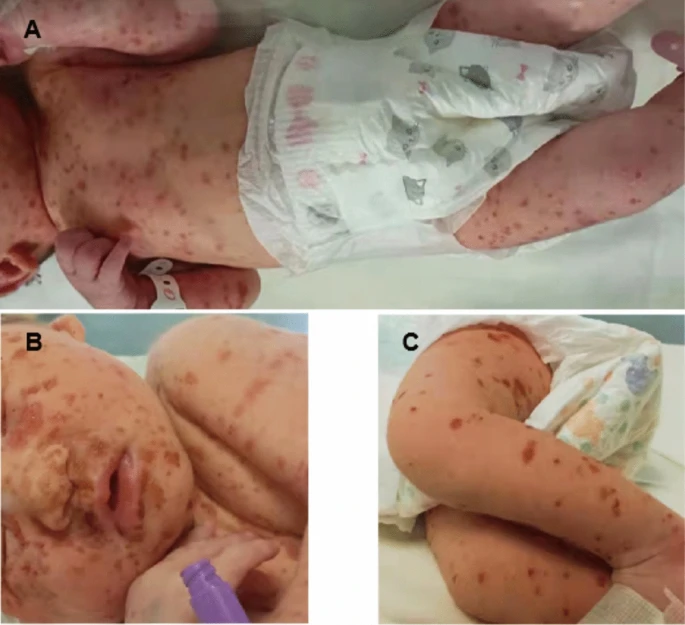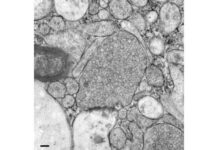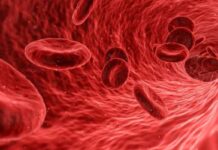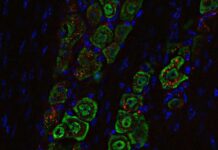Case Report
Langerhans cell histiocytosis (LCH) is a group of idiopathic disorders characterized by the presence of Langerhans cells. While the exact cause is unknown, it has been associated with neoplasia, immunological activation, and dendritic cell abnormalities. LCH is now recognized as a clonal proliferative disease of Langerhans cells that occurs in a hematopoietic cell microenvironment. This study describes a rare instance of LCH in a full-term female infant with numerous lesions.
Case Presentation
A 1-day-old Chinese female child showed with many red papules and cutaneous lesions. As well as an ulcerated core area, since delivery. She was delivered by cesarean section at 38 weeks gestation due to her mother’s uterine scar. There was no major family history, and her mother did not mention taking any systemic drugs while pregnant. The infant weighed 3.13 kg and had Apgar scores at 7 and 8 after 1 and 5 minutes. On the second day after admission to the neonatal intensive care unit, the infant’s vital signs were stable, and she was well-fed.
There were no symptoms of fever, weight loss, polyuria, or other systemic conditions. A physical examination revealed several ill-defined lesions measuring 5-10 mm in diameter on her face, torso, and limbs. In addition, a 0.5-1 cm node was found inside the anus that bled freely when touched. Other physical findings, such as the mucosal membranes, lymph nodes, liver, and spleen, were normal.
The initial differential diagnoses included syphilis, toxoplasma, rubella, CMV, herpesvirus (TORCH) infections, Epstein-Barr virus (EBV), new coronavirus, and human immunodeficiency virus (HIV). However, the serological tests for these illnesses were negative. Except for the laboratory values shows, hepatic and renal function, blood electrolytes, a chest radiograph. And blood cultures all returned normal results. A skin biopsy from a lesion on the right lower limb revealed modest atypical hyperplasia of the squamous epithelium, karyokinesis, and interstitial inflammation.
Management
After consulting with a dermatologist, the infant was given fusidic cream to prevent skin infections and human epidermal growth factor gel to aid healing. In addition, she was given intravenous ceftazidime, a broad-spectrum antibiotic routinely used to treat neonatal infections. Physical examination revealed that the ulcerative lesion had resolved, and a maculopapular and peeling scab had formed, which lasted until the fourth day. The LCH diagnosis was verified after transferring the biopsy samples to Shanghai Children’s Medical Center.
Discussion
When a newborn appears with erythematous papulovesicular lesions, there are multiple differential diagnoses to consider, including viral and neoplastic disorders. Similarly, viral diseases such as herpes simplex virus (HSV), varicella, TORCH infections, syphilis, congenital candidiasis, bullous impetigo, and listeriosis should be considered. Rare neoplastic diseases such as congenital leukemia, LCH, and neuroblastoma may be ignored in newborns with erythematous cutaneous lesions.
In this case, diagnostic tests ruled out HIV, EBV, TORCH, syphilis, and septicemia.
Despite the increased procalcitonin (PCT) level, the newborn had normal feeding patterns, and the rash gradually improved with prescribed treatment, which included medication and nursing interventions. Initial skin biopsy with hematoxylin and eosin (HE) and immunohistochemical staining did not give a definitive diagnosis, as LCH was not initially evaluated due to its rarity in neonates. Symptoms of LCH include fever, rash, hepatomegaly, lymph node enlargement, and usually associated progressive anemia, granulocytopenia, and thrombocytopenia.
LCH is commonly ignored or misdiagnosed without a thorough histology, immunocytochemistry, and electron microscopic study. This creates considerable hurdles for pediatric medical teams in making timely diagnoses and commencing appropriate therapy for newborns with LCH.




